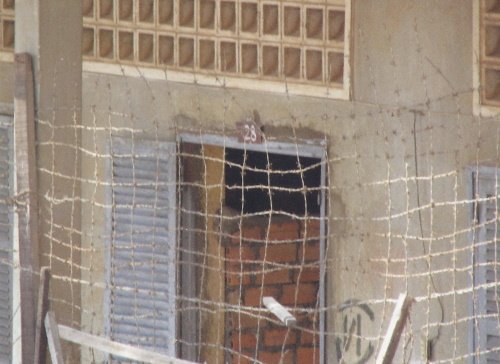Els Slots
Tuol Sleng Genocide Museum
A few weeks ago, Cambodia has added 3 of its genocide memorials to the Tentative List as a serial proposal. The sites commemorate the victims of the Khmer Rouge regime, which was overthrown in 1979. The proposal still has the cumbersome working title “ Former M-13 prison/ Tuol Sleng Genocide Museum (former S-21)/ Choeung Ek Genocidal Centre (former Execution Site of S-21) ”.

I visited the former S-21 prison, now known as the Tuol Sleng Genocide Museum, in 2007. It is located in street 113 in the heart of Phnom Penh. In 2007 it saw some 50 visitors a day, but probably this has risen over the years due to the increase in global tourism - it is one of the few obvious “things to do” in the Cambodian capital. It is also a well-known place on the Dark Tourism circuit. Unfortunately I lost most of the photos of my visit, but I do still have my diary notes and the leaflet that was handed out upon entering the site.
The prison was located in an old school building. Between 1975 and 1978, some 12,000 prisoners were detained and tortured here. When further questioning was of no use, the prisoner was taken to the out-of-town Killing Fields (such as Choeung Ek, the third location of this serial tentative site). There he or she ended up in a mass grave.
The museum still resembles a school building, with classrooms, long corridors and a playground. The classrooms were divided into cells of about 2 by 1.5 meters. Parts of these have been preserved, just like the medieval-looking torture instruments. A climbing frame on the playground was used to hang prisoners.

In a number of rooms you can see original photos of those who were detained here and later killed. Among them also many members of the Khmer Rouge, who were no longer trusted. They are recognizable by their black suits and standard hairdos.
In a cinema room upstairs, the movie "Bophana" is shown which tells the human story behind this mass murder. During the Khmer Rouge regime, 2 million Cambodians lost their lives through starvation and destruction. At least two things happened that also characterize other genocides: there was a fairly large number of collaborators / sympathizers (sometimes out of conviction, but also out of opportunism or fear) and easily influencable child soldiers were used.

To determine whether this site has any chance of inscription, we must await the WHC meeting of 2020 for the results of the evaluation of “sites associated with recent conflicts”. In 2018, advisory bodies ICSC and ICOMOS each had already written their advice from which a few criteria can be filtered out:
- There should be a common importance for the international community as a whole;
- Sufficient time should have elapsed;
- All stakeholders should be involved. The narrative should be impartial and/or multiple narratives should be recognised;
- There has to be tangible fabric left related to the events (preferably outstanding on its own).
It takes an expert to really measure the 3 Cambodian genocide monuments against these criteria, but a few things do stand out:
- The Cambodian genocide certainly was a globally relevant event and it remains one of the most deadly genocides to date. Also, the aspired agrarian-autarkic society was “one of the most extreme examples of sociological experiment a regime or government ever tried to put in practice” ( source ).
- The killings stopped in 1979, but the regime held on to its UN seat until 1983 and only in 2003 Cambodia and the UN recognized their specific crimes to humanity (leading to the jailing of two of its leaders in 2014). So it is still relatively fresh, however “Cambodia has a very young population and by 2003 three-quarters of Cambodians were too young to remember the Khmer Rouge era” ( source ).
- Cambodia still appeared to be struggling with inclusion and the avoidance of political whitewashing as recent as 2015 ( source ). However, the Killing Fields site of Kraing Ta Chan is described by ICSC as a “good practice of interpretation” - surprisingly that site is not among the 3 locations included in this tentative proposal (it is mentioned in the comparative analysis and maybe dismissed too lightly).
- All 3 locations have immovable tangible fabric left. Tuol Sleng is probably the best preserved, but it would be a stretch to declare this concrete school building as a monument on other grounds than its link with the prison activities.
More on
Els SlotsComments
No comments yet.
